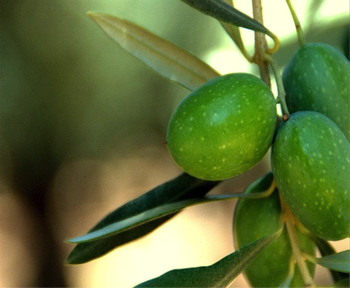Olive
-
Scientific NameOlea europea
-
General InformationThe olive is a subtropical evergreen tree with gray-green elongated leaves that are hairy on the undersides to slow the rate of transpiration -- a useful trait in dry climates. Most olives are grown for their edible fruit, but fruitless varieties are available. Dwarf olive trees are also available.
 Photo: website “UCANR”, Manzanillo Olive
Photo: website “UCANR”, Manzanillo Olive -
When to Plant
Plant new olive trees in the spring after danger of frost has passed or in the fall before winter rains arrive. Give the tree enough room, as it will grow at least 20 to 25 feet tall.
-
Planting
When planting an olive tree, plant it high, keeping the crown above the soil line. For good tree growth, the soil should be dry with good drainage. Dig a hole as deep as the root ball and twice as wide. The width of the hole helps the roots spread faster. Check for girdling roots, cutting them off before placing the tree. In areas with poor drainage, consider mound planting. Do not fill the planting hole with amended soil, but rather shovel soil from surrounding area around the roots to form the mound. Water the tree and leave the nursery stake to stabilize it until roots grab hold. Consider painting the lower two thirds of the tree with one half water and one half interior, white latex paint to protect from sunburn and borers. Water newly planted tree deeply and apply mulch three inches away from the crown and trunk.
-
Soil Requirements
Tolerates poor soil but fares better in rich soil.
-
Water Requirements
Newly planted, young trees need more water because they have smaller root systems. It is generally better to water thoroughly and less frequently. Water to a depth of two feet. With mature trees, monthly watering is usually sufficient. Over watering may result in non-beneficial growth that increases pruning requirements as well as the risk of pests and diseases.
-
Fertilizing
Fertilizing mature trees is not necessary. Fertilize young trees with one ounce of organic urea (a high nitrogen fertilizer found in animal manures) or another high volume nitrogen amendment such as blood meal under each drip emitter every month.
-
Pollination
Olive trees are pollinated by wind with an assist from bees. Some varieties are self-fruitful while other varieties need a specific pollinizer.
-
Harvesting
Olive trees usually bear fruit by the fourth or fifth year and fruit in alternate years. The crop ripens in late fall. It is a time consuming crop to harvest, with each tree producing as much as 40 pounds of olives. The fruit turns from green to black as it ripens. Some olives are picked green for brining as table fruit. If you choose to press them for oil, you can harvest either green or black although oil from green olives is purportedly of higher quality. The fruit must be cured to be edible. Learn more about processing olives.
-
Storage
Community press events request olives be picked as close to press day as possible. Once pressed and bottled, olive oil is best if used within the first year of pressing. Depending on conditions, it may keep for up to two years.
-
Good Varieties for Marin
The following varieties are available in local nurseries and yield great olives:
Table varieties: ‘Manzanillo’ ‘Mission’
Oil producers:
'Arbequina’ (verticillium resistant and self- fruitful)
‘Leccino’ (early bearing and needs ‘Maurino’ as a pollinator)'Manzanillo’ (medium oil content and needs ‘Arbequina’ as a pollinator)
‘Mission’ (self-fruitful, readily available and has a high oil content)
Non-fruiting: 'Swan Hill'
-
Helpful Tips
Manage pests and diseases with good cultural practices. To mitigate olive fruit fly infestations, remove all fruit from tree, pick up fallen fruit, and discard. Also hang traps filled with a mixture of torula yeast and water in trees before fruit appears. And lastly, before selecting a cultivar, pick your planting spot and determine your criteria, i.e. do you want to eat olives or make olive oil?
Pruning: After planting a young tree, break off suckers. Prune olive trees annually after harvest to maintain shape and height. Also, when a young tree reaches about three feet tall, reduce scaffold branches to between three to five branches to simplify picking.
-
Common Problems
Olive trees make a lot of litter that can leave dark stains. Plant far away from a patio, pool, sidewalk, pathway, or driveway.
-
Pests- Diseases & More
Olive trees are susceptible to peacock spot, identified by a yellow halo around a spot. The disease reduces productivity but can be controlled by application of a copper fungicide in late fall before rains arrive. Olive trees are also subject to root rot (watch irrigation) and verticillium wilt (monitor water and fertilizer and buy disease resistant varieties).
Learn more about growing olive trees.

